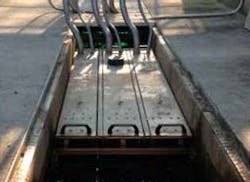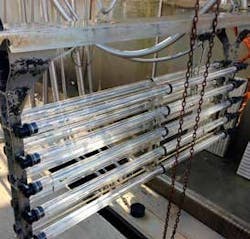Summerville, GA, a small city in the northwestern part of the state and the county seat of Chattanooga County, built their 2-MGD wastewater treatment plant in 1967. It was designed to handle the flow from a developing municipal collection system that now serves 1,860 connections.
Project Background
During an upgrade in 2008, the city’s consulting engineers recommended abandoning chemical disinfection in favor of replacing it with a WEDECO UV system. The system consisted of 60 lamps configured as two banks of three modules each, set in a single open channel. As other elements of the upgrades that year, the plant received air diffusers, a blower motor, an additional pump and improved lighting.
Two of the original lamps needed to be replaced, so plant operator Scott Millican urged his superintendent to proactively replace all the lamps in the system to ensure the system was operating at its highest level of efficiency.
“Our former superintendent mistakenly presumed that all UV lamps were essentially the same. He went with the lowest price which set the stage for trouble.”
Lower priced, aftermarket lamps were purchased through an alternate lamp manufacturer and installed in the UV system. They failed to meet expectations within eight months.
“We ran [the new lamps] only one year but even at 100 percent power, our fecal counts were close to exceeding our permit,” Millican said. “We sought quotes for several lines of replacement lamps but were committed up front to the originals. Both the city manager and new superintendent agreed the higher cost was logical because the lamps were matched to the system.”
This led the superintendent to earn approval for emergency procurement of WEDECO’S ECORAY® lamps as replacements.
Beyond the eco-friendly benefits of the WEDECO ECORAY® UV solution, it is more efficient and longer lasting than any previous WEDECO UV lamp technology.
Result
The new ECORAY® lamps and companion electronic ballast cards were installed and were an immediate improvement. At the Summerville plant, the energy use has been significantly reduced and experience has shown us that total operating costs have been typically reduced by 20 percent at many installations because the lamps normally operate more efficiently in dimmed mode but still achieve the required disinfection.
The ECORAY® line of UV lamps also incorporates environmentally friendly engineering features. The lamps contain 80 percent less mercury and can reduce the carbon footprint by 1,100 lbs. of CO2 in each lamp. The manufacturer, WEDECO meets the highest environmental standards for Certification to DIN EN ISO 14001.
Following the initial weeks after installation, the system was reverted back to an automatic dosage setting of 36 mJ/cm2 which best serves the plant’s limited workforce. The experience proved one point to the Summerville operators when it comes to purchasing replacement lamps, and in general, other aftermarket parts. Chris Tuggle, the current plant superintendent said, “the lowest price doesn’t always guarantee the best results.”
Editor's Note: Scranton Gillette Communications and the SGC Water Group are not liable for the accuracy, efficacy and validity of the claims made in this piece. The views expressed in this content do not reflect the position of the editorial teams of Water & Wastes Digest, Water Quality Products and Storm Water Solutions.

